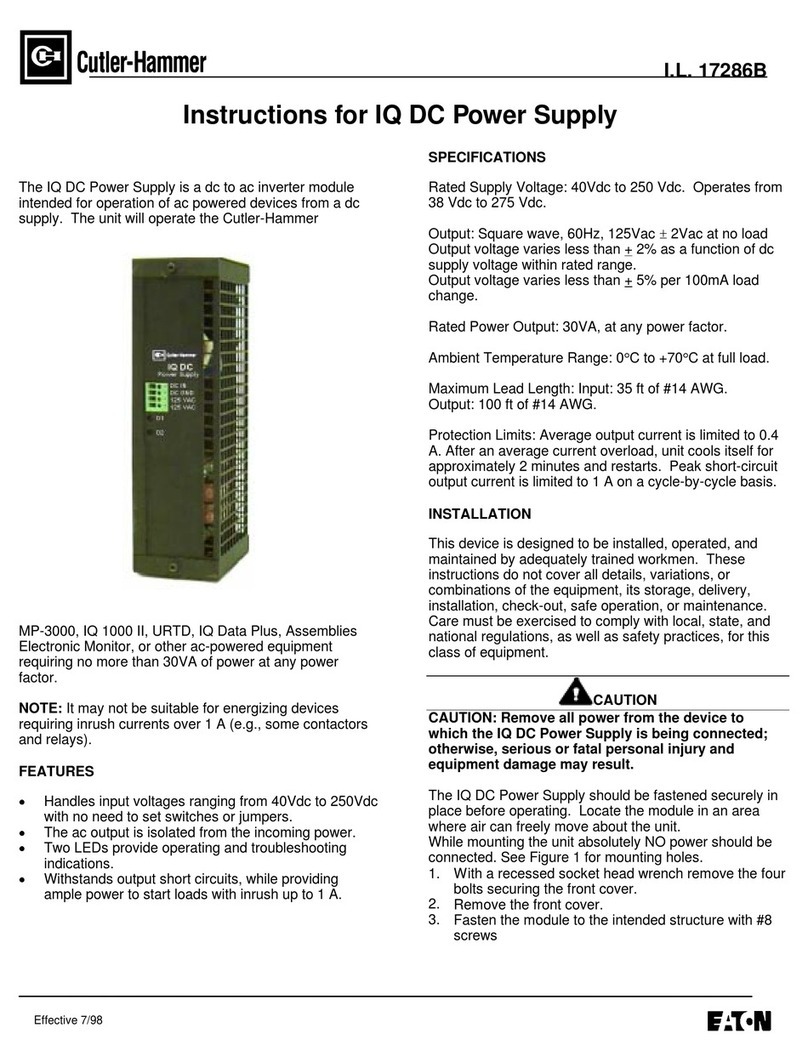Page
8
SECTION 2
INSTALLING INDOOR SWITCHGEAR
2.1
OUT
LINE
OF
INSTALLATION PROCEDURE
1. Prepare the installation foundation. It is
recommended that fl
oor
channels be imbedded in
the foundation to maintain a level surface.
2.
Al
the factory the switchgear system may have
been divided into groups to facilitate shipping. At
the installation site the groups must be rejoined
to
form the switchgear system. Align the groups, side
by
side, on the
ti
e bolt holes.
3.
Bolt the groups together through the tie bolt holes.
4. Bblt or weld the base members of the vertical
section frame, front and rear, to the foundation
channels.
5. Remove all shipping braces.
6. Connect the ground bus.
7. Install
the
primary bus supports, insulated phase
conductors, and rubber snubbers removed for
shipping.
8. Reconnect the wiring between shipping groups.
Run the control wiring for remote apparatus through
the conduits in the foundation (
or
on top of the
ver
tical sections).
9. Replace the metal barriers in the bus
compartments.
10. Connect the main power cables and fully insulate
the terminals for the voltage class (SEE SECTION
10
& FIG. 14 FOR GUIDELINES).
11
. Replace the rear covers
on
all the vertical sections.
12
. Check the operation
of
the levering-in system in the
breaker compartments.
13
. Check the potential transformers and the control
power transformers in the auxiliary compartments.
14. Perform loading check on both control and primary
circuits to assure the system is ready for operation.
2.2 DETAILS OFTHE INSTALLATION PROCEDURE
1. PREPARE THE FOUND
AT
ION
REVIEW THE INSTRUCTION.BOOKS AND
DRAWINGS
CA
RE
FULLY.
A. Locate the switchgear so there is enough aisle
space at the front and rear of the system.The
amount
of
space recommended is shown in Fig. 2.
1.8.
32-255
B. Leave enough space so the doors can be opened
and the breakers and transformers can
be
pulled
out for inspection and
ma
intenance. Leave enough
space at the rear so there will be room to install the
cables and
to
perform whatever inspection and
maintenance that may be necessary.
THE MINIMUM CLEARANCES ARE SHOWN IN FIG. 2.
REFER TO THE FLOOR PLAN DRAWING FURNISHED
WITH EACH ORDER.
C. Make sure the foundation is flat and level.
D. Design the foundation so
it
will be strong enough to
support the weight of the switchgear without
sagging. Table 1 gives the weights
of
the various
ratings
of
switchgear and breakers.
Be
sure
to
take
into account the shock
or
impact weight that occurs
when the breaker trips and when it closes.The
impact weight is 1.5 times the weight of the breaker.
The weights
in
the tables are only an approximation.
The actual weight will vary, depending on the type
and
th
e amount of equipment in the switchgear. Use
adequate safety factors.
E. The recommended foundation consists
of
steel
channels embedded in a level concrete floo
r.
The
channels must lie in a flat and level plane. (A slope
of 0.125 inch in 3 feet in any direction is
acceptable.) In no case may the non-supporting
areas of the foundation be higher than the tops
of
the steel channels.
The anchor bolts, channels, and other materials are
to be furnished by the purchaser
of
the switchgear.
A 4-inch structural channel is recommended as the
minimum size for the average indoor switchgear
system.
If unit substation transformers
or
high voltage
switches are
pa
rt of the Installation, be sure the
floor steel underthe transformer conforms
to
the
specifications
of
these manufacturers.
F. Install the conduits in the foundation.
When
th
e primary and secondary cables enter the
switchgear from below, the conduits that carry them
are embedded
in
the foundation.A floor plan
drawing is furnished with each order. Use this
drawing to determine the conduit layout, the circling
of
the steel around single phase conductors rated
600 amps
or
more should
be
avoided to prevent
overheating due to induced currents.
Effective
12/97




























